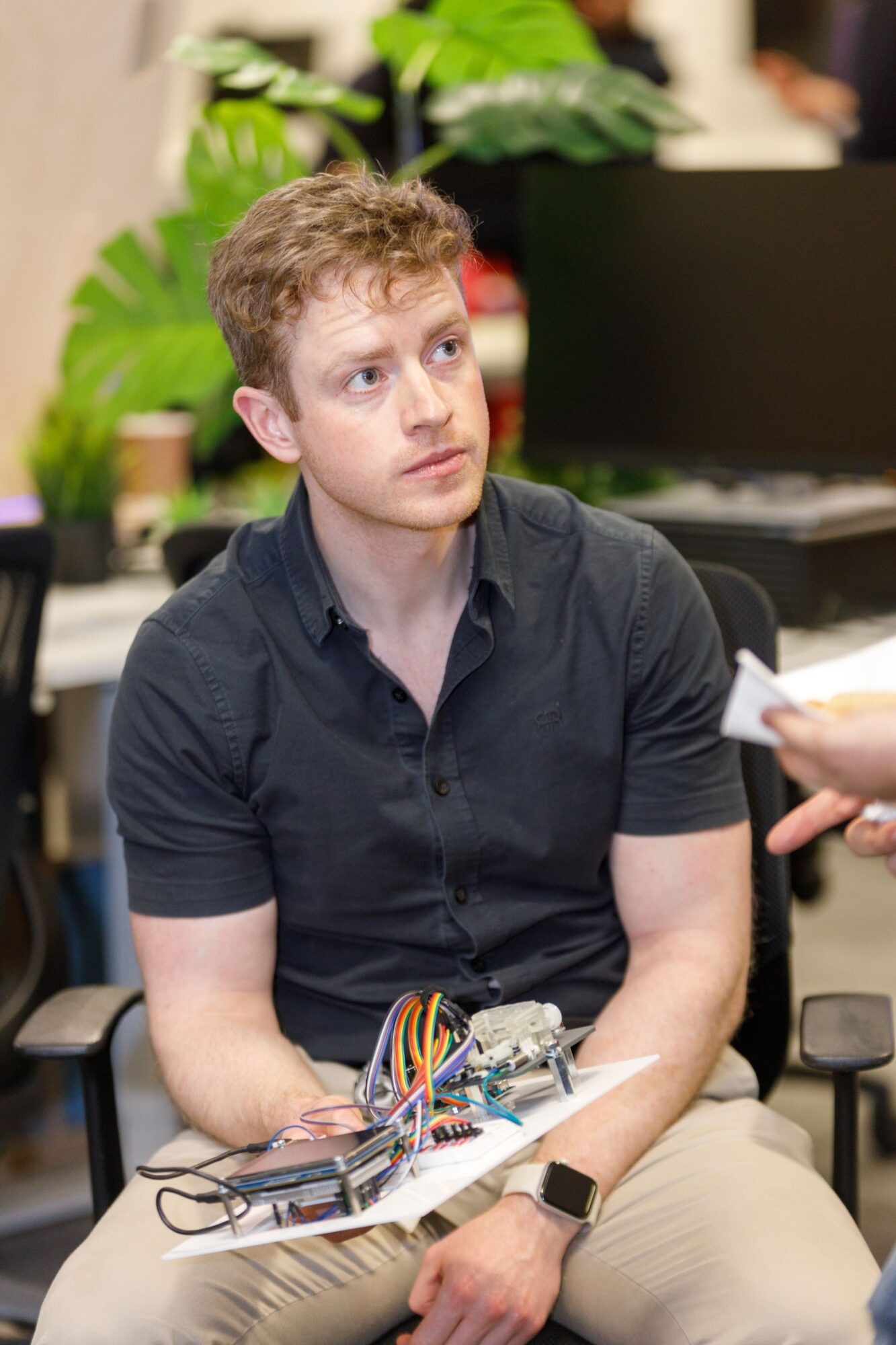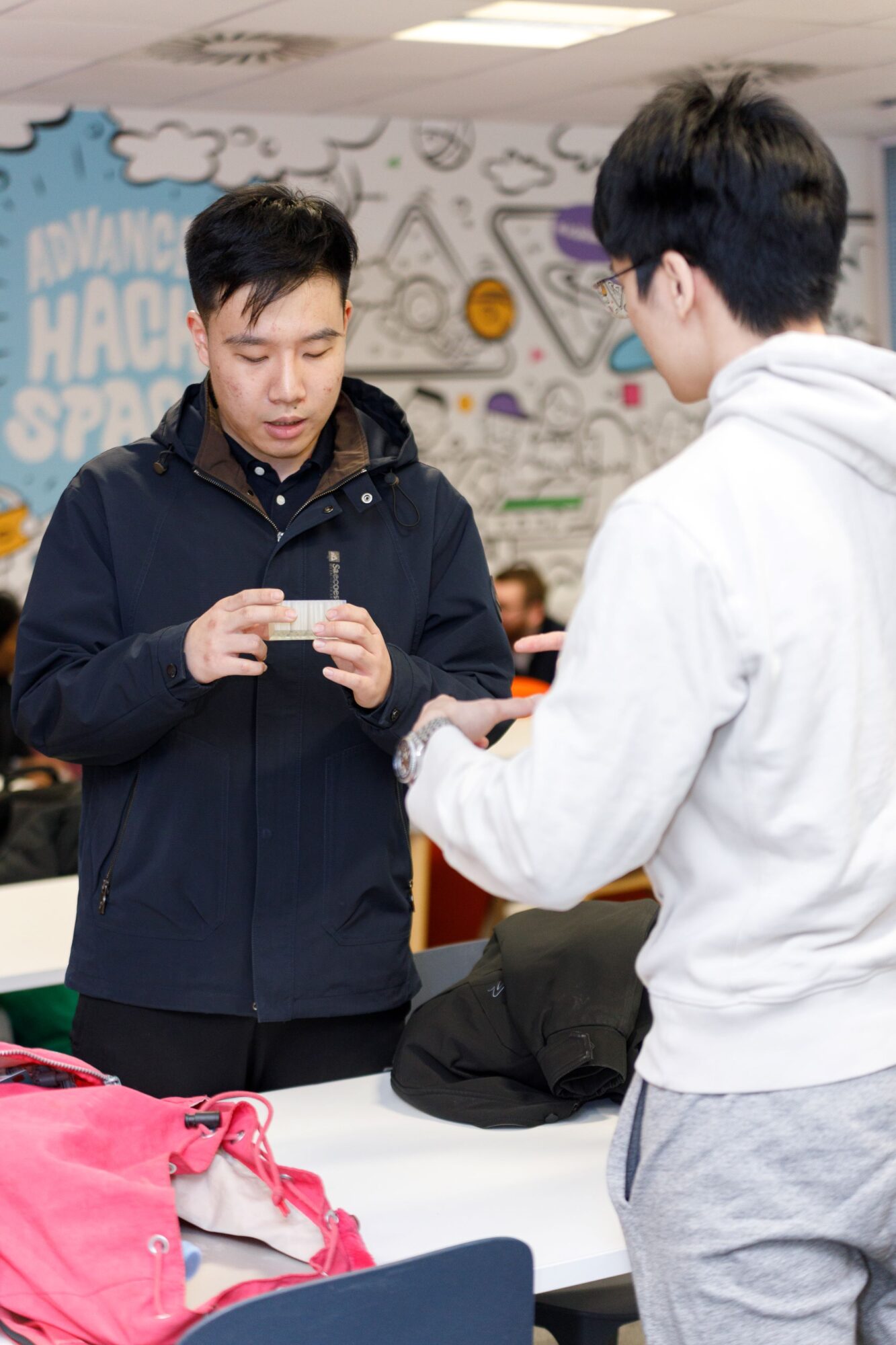About Hackstarter
Hackstarter is a grant programme giving inventors at Imperial the ability to make prototypes of their early-stage concepts.
Run by the Advanced Hackspace, the scheme enables students, staff and alumni to create physical products in our maker space using traditional and digital prototyping equipment, offered in a supportive and inclusive learning environment.
Over a ten week programme, selected teams have the opportunity to develop their early stage prototypes with the assistance of a £500 grant towards materials costs.
Visit the Hackstarter page to learn more about the programme.

Grand Final 2024
At the Hackstarter Grand Final on 15 March 2024, we showcased this year’s cohort of inventors and the novel solutions they have created.
Our innovators demonstrated their exciting ideas and early-stage prototypes for new medical devices, sustainable skincare, green energy capture, therapeutics and more!
The top teams pitched their concepts to a panel of judges for the chance to win an additional £2,500 in “Hack Credits”. Each team presenting received a further £500 worth of credits as a runner-up prize.
Meet Our Teams
Meet our 2024 cohort buzzing with great product ideas and the drive to turn them into reality. Click on each category below to discover their innovations and future plans.
(Teams marked * are Competition Finalists).
Browse our innovation categories:
Robotise
A glove that will translate text to braille on demand.
In time, our plan for this product is to gradually upgrade it to provide useful information about the wider environment such as the weather conditions and how crowded destinations are in real time.
Vein Visualiser
Improving the accuracy of intravenous injections.
Intravenous injection is commonly used to administer pharmaceuticals in medical procedures. However accurate location of veins can sometimes be problematic.
Our device enhances the accuracy and efficiency of intravenous injection by using an adjustable LED light to visualise the vasculature. Veins can be easily identified, facilitating their accurate location and improving the success rate of injections.
Biological R&D
A new test for the rapid and accurate detection of disease-causing bacteria.
We are creating an E.coli diagnostic test that enables the rapid and accurate detection of disease-causing bacteria. This can be utilised for medical diagnostics and food safety purposes.
Our plan for the first phase of this project is to synthesise the metal organic framework required to carry some DNA oligonucleotides (fragments of DNA).
From a learning perspective, our aim is to enable undergraduate students to directly access novel research.
In future, we hope to begin to validate some of the genetic components of our project.
Artificial Skin*
Harnessing biomaterials to synthesise artificial skin.
Current skin substitutes are typically made from mammals (e.g. humans and pigs) resulting in limitations due to the risk of immunological rejection.
Our team is developing a novel single-layer durable “Jellyskin” substitute that is designed to minimise immunological rejection after its transplantation.
The artificial skin is fabricated using 3D bio printing, bringing together bacterial polyhydroxybutyrate, jellyfish collagen (which also has abundant antioxidants for anti-ageing), elastin and brown algae.
T Cell Selector Device
A device to better identify T cell suitability.
T cells are a type of white blood cell that helps the immune system fight off and protect against disease. Selecting the best cell candidates of T cells in cell-based immunotherapy is very inefficient (3.4% overall success rate) and expensive (~$2.8B per approved drug).
Our solution is to use a microfluidic device. T cell candidates are chosen based on how strongly they bind to cancer cells (their cell avidity). The device works by lining the microfluidic channel with a monolayer of cancer cells first, and then introducing T cells through the inlet so that the T cells will have a chance to bind with the cancer cells. It slowly amps up the pressure to push the T cells and test which cells remain after a certain level of pressure. The higher the cell avidity, the more pressure the cells can withstand. These cells are then collected at the outlet of the device, and used for further testing and development.
Our current goal is to use automation to make our device easier to use and more readily adoptable by pharmaceutical companies.
'Reciprotect' Solution
Preventing the development of Hand-Arm-Vibration Syndrome.
Hand-Arm-Vibration Syndrome (HAVS) is an irreversible condition that affects the hands and arms caused by continuous exposure to vibrating surfaces or hand tools. Construction workers are especially at risk of developing this syndrome.
This project aims to prevent the development of HAVS in the hands and arms of users by reducing the vibrations that are felt, specifically when using reciprocating saws.
Our prototype design is a dampener (made using a combination of springs and viscoelastic material) which has been integrated into a bracer, allowing it to attach easily to a saw, whilst also being worn on the hand and arm of the user.
By decreasing the intensity of exposure to extreme vibrations, this design protects the blood vessels, nerves and other muscular tissue in the hands, thus preventing the onset of HAVS in users of power saws.
'iBrain' Focus Tracker *
Brain activity tracking device for the management of ADHD
ADHD and difficulties focusing are well-documented.
Research points towards people with ADHD having specific maturational delays within the default mode network (responsible for all the day-dreaming we do) and the task-positive network (when we’re attentive).
This hindrance can be measured, logged, and better understood using existing technology.
Our device will read activity signals in the focus region of the brain, tracking shifts in brainwaves and interpreting optimum attention states. It allows ADHD sufferers to monitor and quantify their capacity to be attentive, enabling greater self-knowledge and the ability to adjust to brain activity changes.

Pictured: Hackstarter 2024 Mid-term Meet-up
Treeva Turbine
Turbines which generate renewable energy using winds from passing transport.
A large portion of the energy used to power transport is lost to its surroundings.
The team at Treeva has designed highly efficient vertical-axis wind turbines which rotate due to the airflow of moving vehicles and generate renewable and reliable power.
The body of the turbine was previously completed in Hackspace and tested in the field. We are now creating a new blade design. Read more >
Saol Nua
A biodegradable alternative material to oil-derived polyester.
PHA bioplastic is a type of biodegradable material produced by microorganisms through the fermentation of renewable resources. In this research and development project, we are using bacteria and seaweed to produce PHA. In dried form, this can be used directly in both dry injection moulding and textile weaving.
With the support of Hackstarter, we will be producing sample amounts of PHA plastic to demonstrate our concept.
Air Quality Monitoring
Testing a cheaper, solar powered solution for air quality monitoring.
Our project aims to develop an alternative solution by employing multiple small air quality monitoring nodes (which are mounted onto a moving vehicle such as a bus or tram) and using off-the-shelf particle counting air quality sensors.
The sensors are low-power units which run off solar power.

Pictured: Hackstarter 2024 Mid-term Meet-up
Sustainable Emollients*
The sustainable production of skincare ingredients using yeast.
Squalane is an emollient used to hydrate the skin and hair by the cosmetics industry. Initially derived from shark liver, plant-based alternatives include using sugar cane. However this procedure involves using heavy metal catalysts which negatively impact the environment.
Our project explores the microbial production of emollients, and the potential of yeast and other microorganisms for the production of other compounds for skincare treatments such as collagen.
Ecoflav SPF Protection
A plant-derived SPF moisturiser that is eco-friendly and affordable.
Our goal is to use environmentally conscious materials extracted from waste fruits and vegetables in the production of a SPF moisturiser. The primary UV filter in our product is flavonoids which are naturally-producing compounds with UV-protection and antioxidant properties.
Interactive Digital Art
A digital artwork installation that interacts with the public.
Our project promotes the role of STEM in art and raises awareness of coding being a medium in digital art.
Using code, machine learning and the information taken from motion capture cameras, we propose a digital art screen that interacts with its environment.
For example, the visual display will change based on the direction of people walking past and the colour of their clothing.
Swimming Turtle Robot
A biomechanically-accurate free-swimming Green Sea Turtle robot.
Sea turtles can be used as an ‘analogue species’ to help us learn more about the swimming method of extinct plesiosaur dinosaurs.
The robot will be used to measure the thrust and efficiency of the swimming stroke of turtles. The readings can then be compared to literature on turtle swimming to show that the robotic method is capable of producing accurate measurements. Our aim is to validate work on plesiosaur hydrodynamics. Read more >
Microfluidic Device*
A device to accelerate and simplify microfluidic research.
Microfluidics is the creation and study of devices in which the characteristic length dimensions are on the order of microns. At this length scale, the properties of fluids are quite different from what might be intuitively expected.
This project seeks to prototype a new ergonomic Self-Contained Microfluidic Pressure System as a robust, user-friendly, and space-efficient solution for microfluidic applications. It promises to enhance laboratory workflows through its innovative design, addressing the limitations of current market options while opening up new possibilities for researchers and professionals in the field of microfluidics.
High-pressure Microseparator*
A solution for separating microemulsions effectively.
Emulsions are spontaneously formed from surfactants, co-surfactants, oil and water. Microemulsions (containing micrometer-sized droplets) have advantages including ultra-low interfacial tension, high selectivity and stability.
Separating microemulsions in continuous flow is key in chemical, biological and pharmaceutical engineering microprocess industries. The shortcomings of current microseparators include clogging, low flux and high manufacturing difficulty.
Our goal is to find a rapid manufacturing and testing method for high-pressure microfluidic components, scalable for mass production.

Award Winners
Congratulations to this year’s winning entry, the Microfluidic Device, for taking home the Grand Final prize. As this year’s Hackstarter winners, the project team benefits from a £3,000 grant towards materials costs to further develop their device.
Bravo also to the Interactive Digital Art project for winning the “People’s Choice” award. Their dynamic STEM-based art installation captured our audience’s attention.

Thank you to everyone who joined us for the 2024 Grand Final and to all our participants. Everyone who took part has much to be proud of. One afternoon really wasn’t sufficient to do justice to the hard work, effort and brainpower that has gone in to producing such diverse and creative innovations. The extremely high standard of work produced by our Hackstarters was inspiring, as was the speed with which they have accelerated their innovations over a relatively short 10-week programme.

